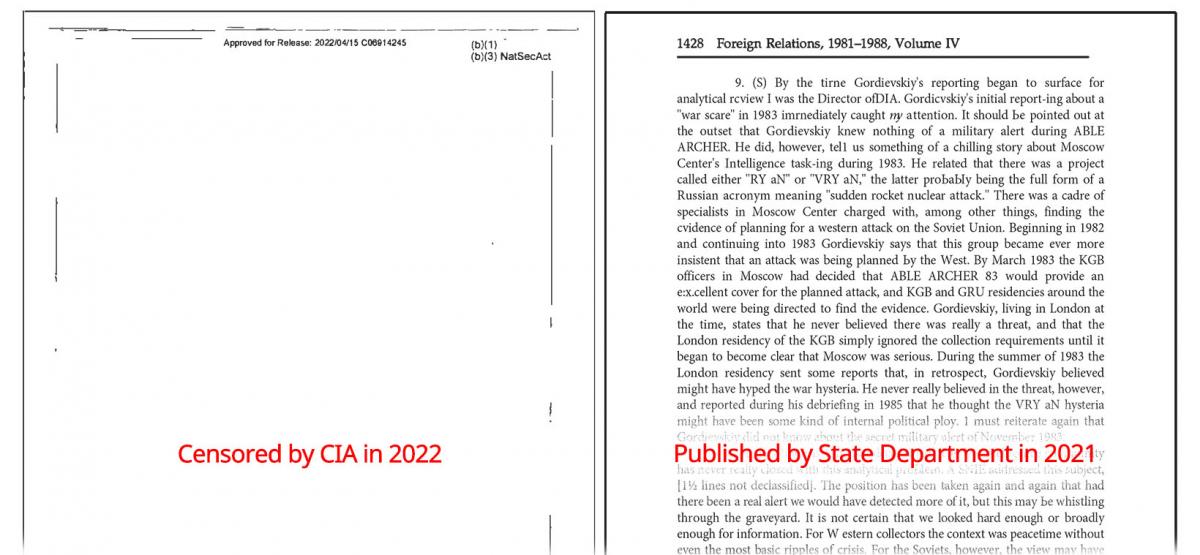Washington D.C., October 4, 2022 – Federal judge James Boasberg today supported a CIA claim that a public document about a famous nuclear war scare should be censored “to protect ‘intelligence activities’ or ‘intelligence sources or methods,’” despite the fact that his ruling and the CIA’s argument actually highlight the information and undermine any such protection.
The document in question is the “end of tour” memorandum written by the retiring director of the Defense Intelligence Agency (DIA), Lt. Gen. Leonard Perroots, in January 1989. The Perroots memo called into question the U.S. intelligence community’s downplaying of the nuclear danger during the annual “Able Archer” NATO military exercise in November 1983 and sparked a formal investigation by the President’s Foreign Intelligence Advisory Board (PFIAB) that found Perroots was right. (The general had served as Assistant Chief of Staff for Intelligence, U.S. Air Forces Europe, during the 1983 exercise.) The Board concluded, after an all-source review, that the U.S. “may have inadvertently placed our relations with the Soviet Union on a hair trigger” during Able Archer, and commended Perroots for having avoided any escalation.
The Boasberg ruling today came in a Freedom of Information lawsuit brought by the National Security Archive against the Central Intelligence Agency (CIA) seeking its copy of the Perroots memo, since the DIA has apparently lost its own copy. The law firm Beveridge & Diamond represents the Archive pro bono in both cases, led by John Guttmann and Hilary Jacobs. Remarkably, Judge Boasberg repeatedly apologizes in his text: “Once again, the Court begs Plaintiff’s indulgence, as it must be vague.”
The highly classified PFIAB report that the Perroots memo triggered was declassified in 2015 by the Interagency Security Classification Appeals Panel after a 12-year request and appeal effort by the National Security Archive and made front-page news around the world.
The Archive and its then-FOIA director, Nate Jones, then identified the specific boxes of retired DIA files at the Federal Records Center in Suitland, Md., where the Perroots memo must be located, and brought a lawsuit against the DIA when it did not respond to the FOIA request. DIA ultimately told the court that the document was lost, despite its classified status, which requires special protection and handling.
State Department historians meanwhile had located a copy of the Perroots memo in CIA files (the memo criticized CIA’s conclusions about the 1983 danger level) and published the document in February 2021 in the Department’s Foreign Relations of the United States (FRUS) series. Again, headlines around the world highlighted the danger of inadvertent nuclear war that the memo warns about.
The Archive’s lawsuit pointed out that FRUS volumes undergo years of declassification review before publication, including a coordinated CIA review, a process that took years to put in place and has been praised by the members of State’s Historical Advisory Committee as a model for other agencies.
The Boasberg ruling vaguely suggests, on the basis of in camera affidavits from the CIA and from a securocrat at the State Department, that perhaps something went wrong with that review, or that the CIA is still angry about the interagency panel that released the Board report in 2015, or that CIA still resents the statute Congress passed mandating that the Foreign Relations volumes must be accurate—which compelled CIA to cooperate with State historians.
“Kafka would be proud of Judge Boasberg,” remarked Tom Blanton, director of the National Security Archive. “An official publication of the U.S. government released the Perroots memo, but now the CIA attempt to put the toothpaste back in the tube just spreads it all over the sink.”
The Archive today posts the side-by-side comparison of the public Perroots memo and the censored CIA version. (Notably, the memo is no longer retrievable on the State Department’s web site because the FRUS volume containing it has been pulled; officials have stated this was for technical reasons, although it has been down for months.)
Also included in the posting are Judge Boasberg’s ruling and links to the Archive’s multiple postings on Able Archer 83, the President’s Board report, and Lt. Gen. Perroots.
The Documents

1. FOIA release by U.S. Central Intelligence Agency and 2. Foreign Relations of the United States, 1981-1988, Volume IV, “Soviet Union,” January 1983-March 1985, pp. 1426-1429.
This side by side comparison shows the text of the Perroots memo as published in the State Department history series, next to the same page as censored by the CIA in the Freedom of Information Act litigation. All the published text -- even the first paragraph specifically marked "U" for unclassified -- is censored by CIA, which only released the cover page that was not included in the State history volume.

U.S. District Court for the District of Columbia.
Judge Boasberg’s ruling supports the CIA claim that the Perroots memo be classified even though the document has already been published in the State Department’s Foreign Relations of the United States series.

Office of the Historian
This PDF contains the full text of the State Department's Foreign Relations of the United States volume in which the Perroots memo appeared. Published in February 2021, this volume no longer appears on the State Department website, and was recovered by the National Security Archive from the various digital archives that captured it in the public domain in 2021. In this PDF, the Perroots memo is on pages 2710-2714.

